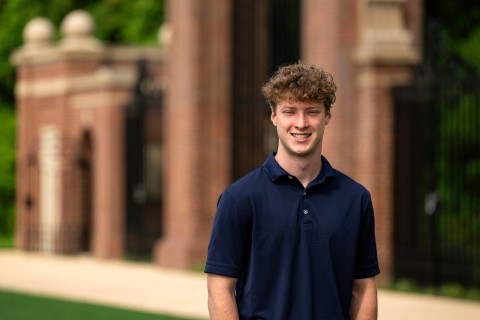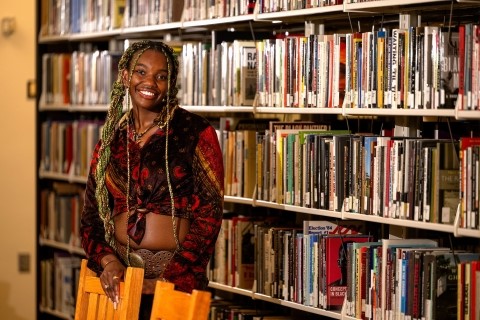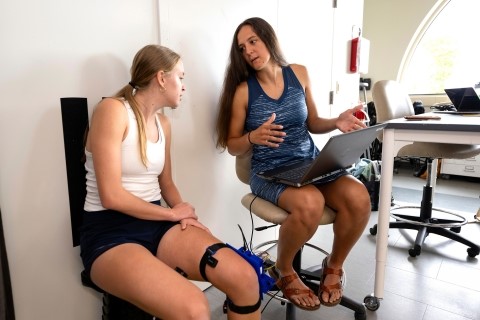Contact:
Mike Ferlazzo
570-577-3212
570-238-6266 (c)
mike.ferlazzo@bucknell.edu
To download full image (below), right-click and choose “save image as”
LEWISBURG, Pa. (August 15, 2024) – Typically, summer break offers students and faculty a well-earned reprieve from the rigor of an academic year packed full with classes, clubs, athletic events and more. However, curiosity and intellectual inquiry don’t take a break just because classes do. These three Bucknellians have been engaged in meaningful summer research that has produced new insights across the University’s three colleges.
Max Wilson ’27, business analytics

It was in a foundation seminar class that Max Wilson ’27, a business analytics major from Boston, wrote a paper mathematically evaluating the voting methodology behind the NFL’s Top 100 list — an annual ranking of the best 100 players in the NFL, according to the players themselves. With the support of Professor Sam Gutekunst, John D. and Catherine T. MacArthur Professor of Data Science, and Professor Joe Wilck, associate professor of practice in Analytics & Operations Management, that paper evolved into a summer research project.
“It’s a lot of spreadsheet work that also requires a working knowledge of football,” says Wilson, whose collaboration with his advisers has inspired him to consider approaches he hadn’t thought of on his own. “I’ve learned a lot about what it means to embrace different approaches to a single question.”
Wilson has been producing “data vignettes” to understand what NFL players most value when ranking each other in the NFL Top 100. Wilson is still in the exploratory phase of the research process, though early results show that quarterbacks and wide receivers are among the prominent players in the Top 100, and everything from public perception to player legacy can substantially impact rankings. The NFL has already expressed interest in this research, and Wilson hopes to gain access to more refined data to continue the study.
Athaliah Elvis ’26, English — creative writing and political science

For Athaliah Elvis ’26, an English–creative writing and political science double major from New York, it was her critical Black studies minor that provided the perfect framework to explore her interests in creative writing, history and literature. With her adviser, Professor Meenakshi Ponnuswami, English, Elvis has been researching how historical movements have influenced Black women writers. “We started off talking about civil rights and Jim Crow, Black Power and Black arts,” says Elvis. “We looked at all of these different movements to understand why, specifically black women, write the way they write, and how these historical movements have influenced their writing.”
Her research demands close readings of poems, plays, essays, art and films by Black writers, as well as a meticulous examination of the historical contexts in which those works were produced. “It’s a lot of close reading and a lot of criticism,” says Elvis, whole copious notes are being used to complete an annotated bibliography and literature review. While reading is a foundational component of her research, it is discussions with her adviser that help translate what she’s read into novel insights. “Professor Ponnuswami has the context of other things that she’s researched, on top of what we’re reading together. So she provides lots of perspective and different critical analysis of the text that reveal things I haven’t necessarily thought about,” she says.
Along with engaging with existing texts, Elvis is also composing her own creative work in response to what she reads and watches, thereby putting her own creative practice in conversation with the artists she studies. “It’s been very enlightening,” says Elvis, whose research revealed how inextricable and foundational Black culture is to American life and the English language.
Madeline Lehker ’26, biomedical engineering

The wall sit, sometimes known as the “imaginary chair,” is both a form of exercise and punishment. For Madeline Lehker ’26, a biomedical engineering major from Hanover, Pa., it’s also an ideal physical activity for studying muscle fatigue. Over the summer, Lehker has been working in Bucknell’s Mechanics and Modeling of Orthopaedic Tissues Laboratory with Professor Benjamin Wheatley, mechanical engineering, to examine the relationship between knee wobble and hip fatigue.
With the help of a computer program, Lehker has been gathering data from sensors attached to human subjects to track muscle signals and movements. Specifically, she relies on IMU (inertial measurement unit) and EMG (electromyogram) sensors to track muscle activation and movement. “We have a patient come into the clinic and we put on a device on their knee and it calculates the amount of knee wobble and then correlates it to the level of hip fatigue,” says Lehker.
At the beginning of study, she and her fellow researchers had planned to use a 90-second wall sit as the baseline amount of time for measuring fatigue. However, after working with different subjects, Lehker realized that some people don’t begin to fatigue within that time frame. It’s this interaction with real subjects that has taught her important lessons about the research process. “I’ve learned a lot about picking the exact muscle location and then writing the protocols for how you are going to put the sensors on people,” says Lehker. “It’s been a lot of fun just fine tuning those aspects of the project.”
-30-

